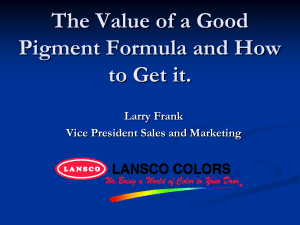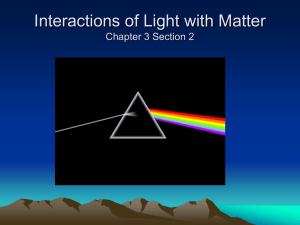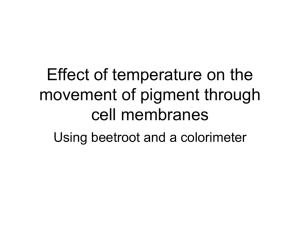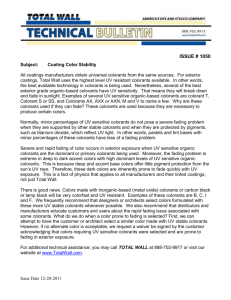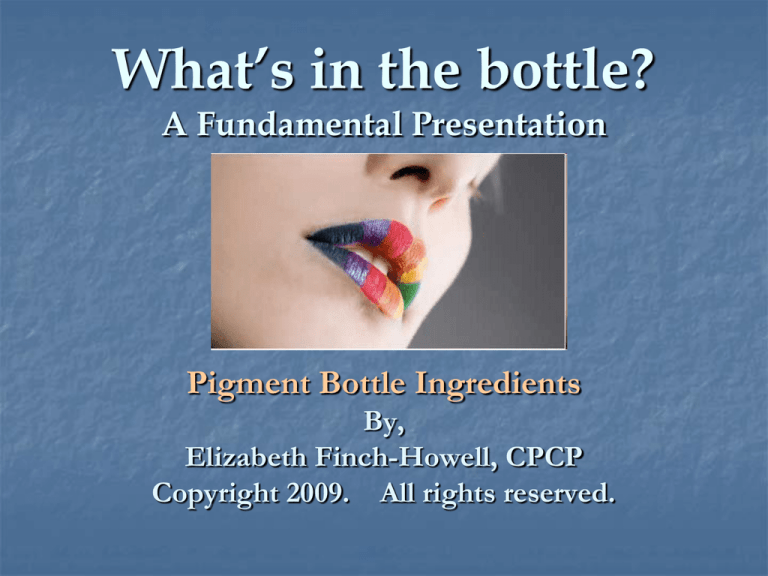
What’s in the bottle?
A Fundamental Presentation
Pigment Bottle Ingredients
By,
Elizabeth Finch-Howell, CPCP
Copyright 2009. All rights reserved.
We are fortunate in having very high levels of
quality ready made pigments from our SPCP
Vendor Suppliers.
For most of us, the information we are supplied
with is sufficient for our needs.
However, you may want to know more and to
do this pigments need to be identified.
Colorants
Pill colorants
Regardless of the product,
colorants used for food,
drugs, and cosmetics are
derived from the FDA’s list
by reputable
manufactures.
Food colorants
Whether taking a pill,
eating a steak, applying
traditional makeup, or
performing permanent
cosmetics, the FDA’s color
additive (colorant) listing
Cosmetic colorants Permanent cosmetic colorants is the source.
Cosmetic Pigment
Bottle Ingredients
Colorants
Additives
Organic
Inorganic
Preservatives
Thickeners
Surfactants
(Binders)
Substrates
(Extenders)
Carrier
Liquid
Colorants
Organic
Soluble
or
Inorganic
Pigments
Dyes
Iron oxide
Natural
Lake
Pigments
Insoluble
Insoluble
Toner
Titanium dioxide
Pigments
Manganese violet
Rubine Reds
Tartrazine Yellow
Lithol Reds
Hansa Yellow
Some less insoluble
As in vegetable black
Ultramarines
Carbon
Colorants
colored, black, white, or fluorescent
Inorganic
Insoluble
Pigments
Iron oxide
Titanium dioxide
Manganese violet
Ultramarines
The general
characteristics
of dyes
Colorants
colored, black, white, or fluorescent
Organic
Soluble
Dyes
Insoluble Colorants
Soluble Colored Particulates
The particulates lose their cyrstalline structure and
dissolve. No separation.
Just as the orange
dye dissolves in
orange soda.
Insoluble vs. Soluble
Essentially physically and
chemically unaffected by the
vehicle or substrate into which
it is incorporated.
Loses its’ crystalline
structure
Does NOT Dissolve
Completely Dissolves
Inorganic Pigment Colorants
are Insoluble
The definition of an inorganic pigment colorant is:
Naturally mined or synthetic (chemical) colorant
such as metallic oxide, sulfide, and other salts.
Earth’s Minerals as a Colorant Source
Two examples of ochre
Blue
Black
Used by all civilizations,
earths colors lend
themselves to a wide
range of uses from
decorating the body to
painting a wall.
Cave Paintings
Earth’s colored
minerals have
been used
constantly
throughout
human history.
Inorganic
and
Insoluble
Pigment
Colorants
Inorganic and Insoluble
Pigment Colorants
Ultramarine Blue,
Pink and Green
Chromium Oxide
Green
Iron Oxides
Titanium Dioxide
Inorganic Iron Oxide Pigment Colorants
Naturally Mined or Synthetically Made
Iron oxides hold a very important place in the
pigment market because of their wide range of
colors, stability, and nontoxic nature.
By far, iron is the most common and stable of all
the elements.
Iron oxides– have iron in its
composition
Titanium dioxide– has titanium
in its composition
Ultramarines – have an
aluminum salt in its composition
Manganese violet – has
manganese in its composition
Iron oxides are
separated into
four major
classifications:
Browns
Reds
Blacks
Yellows
Inorganic Iron Oxide Pigment - Reds
How are They Produced?
One of the methods to produce
red iron oxide is by high
temperature calcining of iron
sulfate to make Fe O (red iron
oxide.)
2
3
Calcining = Roasting at very high
temperatures - over 800 F
Synthetic Brown Iron Oxides are produced by four
methods:
1.
Blends of red, black, and yellow.
2.
Direct precipitation (aqueous)
3.
Calcining (roasting)
4.
Controlled reduction of synthetic black. This form produces
only browns at the lighter end of the brown color spectrum and
are mostly ashy pink browns and gray browns.
Titanium Dioxide
Pigment White 6 -- Color Index 77891
Titanium Dioxide is the most
important white pigment currently
produced commercially.
The pigment is used in a wide range
of applications including inks,
textiles, paper, paints, food, and
pharmaceuticals.
Inorganic Ultramarine Pigments
Blue, Green, and Violet
Ultramarine pigments are insoluble inorganic
compounds that are available in a wide range
of blue shades, green shades, violets, and pink.
They have been assigned the color index
number 77007 and cataloged as Pigment Blue
29, Pigment Green 24, and Pigment Violet 15.
Inorganic Manganese Violet
Pigment Violet 16 – Color Index 77742
Manganese violet is FDA approval for cosmetic
applications. It has excellent lightfastness (8)
and bleed resistance (5). Although it is
manufactured at relatively high temperatures,
it is not a calcined product.
Also, this red-shade violet is a perfect red
shade and not easily achieved by the use of
other pigments.
BLACK
PIGMENT
Three kinds of BLACK PIGMENT
Colorants
Organic
Insoluble
Toner Pigments
Carbon Black
Inorganic
Soluble
Natural
Vine
lnsoluble
Black
Furnace Black
Lamp Black
Thermal Black
Bone Black
Vegetable Black
(semi-soluble)
lnsoluble
lnsoluble
Iron Oxide Black
Carbon Black Pigments
Furnace Black
Lamp Black
Carbon Black Pigment
Thermal Black
Bone Black
Carbon Black Pigments
All carbon blacks are the result of the
thermal decomposition of hydro-carbons.
Vine Black
(Logwood)
Vegetable
Carbon Black Molecule
Although it’s the smallest molecule of all pigment molecules,
the round, very bumpy surface area which reflects
more light is why it is the blackest of blacks.
Black Iron Oxide Molecule
The black iron oxide molecule is cubic and has flat areas which cut
down on reflection.
Permanent Cosmetic and
Body Art Tattooing
Carbon black is on each end with
black iron oxides in the center.
Blacks washed and dried.
Courtesy of Marjorie Grimm, CPCP
Black Carbon Ink
Carbon is the smallest
molecule of all the
pigments. The surface
area of black carbon
ink is multi-faceted
and extremely dense.
Compare Black Iron Oxide and
Carbon Black
Black Iron Oxide is a large molecule
with a flat cubic surface area.
Black carbon ink is a very small
molecule with a large multi-faceted
surface area.
Iron Oxide Black Pigment
Natural and Synthetic
Black exhibits excellent light
fastness.
Compared to synthetic black iron
oxide, the natural pigment grade is
a grayer black, having a weaker
tint strength and a larger particle
size.
The synthetic black is normally a
highly desirable black and used for
pigment manufacturing purposes.
Chemical
Organic
Pigments
Chemical Organic Pigments
The yellow synthetic powder
mimic the bright yellow daisy.
Aside from the natural organics
and inorganics (metallic salts
pigments) organic pigments are
synthetically made up entirely of
chemicals to mimic the bright
colors of natural organics.
Most of these colors are dyes
(soluble) and are combined with
metallic salts to become
insoluble.
Chemical Organic Pigment
Organic pigments are generally brighter, richer
in color, and more expensive than their
inorganic counterparts.
They are also typically less resistant to sunlight,
humidity, and chemicals.
Chemical Organic Pigment
Chemical organic pigments
are characterized as either
Toners or Lakes by the U.S.
International Trade
Commission.
Organic
Lakes
Toners
Chemical Organic Pigment
A TONER is an organic pigment that is free of
inorganic pigment or extenders, as in Carbon Black
Pigment.
It is undiluted organic pigment with maximum
tinting strength.
Toner pigments are INSOLUBLE.
___________________________________
A LAKE is an organic pigment that is a DYE that is
combined with an inorganic pigment or extenders to
turn the soluble dye into an insoluble pigment.
Lakes then become INSOLUBLE.
Natural
Organic
Colorants
Natural Organic Colorants
As a society we normally think of the word “organic” in
relation to the way agricultural products such as food
and fiber are grown and processed.
Organic food production is based on a system of farming
that maintains and replenishes soil fertility without the
use of toxic and persistent pesticides and fertilizers
(chemicals.)
Organic foods are minimally processed without artificial
ingredients, preservatives, or irradiation to maintain.
Natural Organic Colorants
The permanent cosmetic manufacturers do not
use natural organic colorants to manufacturer
tattoo pigments.
This also applies to the body art tattooing
industry.
Natural Organic Colorants
Annatto
Orange #4
Turmeric
Natural
Yellow
#3
Cochineal
Extract
Natural Red
#4
Saffron
Natural
Yellow
#6
Carmel
Natural
Brown
#10
Natural Organic Colorants
Why are natural organic colorants not used for
permanent cosmetic tattoo pigments?
1. The powders are very expensive
2. They are not insoluble.
3. The color variety is not available to supply
the needed hues in demand.
As an example. there is only one natural organic
brown – Carmel, Natural Brown #10 on the FDA
color additive list for food, drugs and cosmetics.
And… most importantly… they are
SOLUBLE DYES
What This Means to Technicians
Suppliers who advertise “organic” pigments are
referring to synthetically (chemically) produced
organic pigments not natural source organics.
They may be relying on the misconception that all
organic materials are without chemical
processing such as in “organically” produced
agriculture.
What This Means to Technicians
In reality, inorganic pigments are from a
natural source (the earth,) organic pigments
are chemically manufactured for cost effective
purposes and variety, whereas true natural
organic pigments are not even used in our
industry.
Natural Organics are soluble dyes.
Preservatives
Preservatives are added to permanent
cosmetics to prevent the growth of
microorganisms such as bacteria and fungi.
Preservatives can include:
- ethyl alcohol.
- sodium benzoate 0.2%
- tetrasodium EDTA
(ethylenediaminetetraacetic acid)
Thickeners
Thickening agents such as polymers are often added to
pigments to change their consistency.
* Polymers can be synthetic (e.i., polyethylene glycol)
or derived from natural sources (e.i, polysaccharides).
Starch and cellulose are examples of polysaccharides.
*
Glycerin (from stearic acid) is a humectant used in tattooing for
thickening and to keep the pigment from drying out.
Glycerin’s molecular Formula: C3H8O3
Glycerin
Pro’s
Con’s
* Pigment doesn’t dry out
* Pigment NEVER dries out
* Keeps carrier solution more
fluid
* Large molecule can impede
placement of pigment
particles
* Large molecule and mass
spreads pigment particles
apart from one another
* Defies gravity and creeps
up and out of LDPE bottles
and most HDPE bottles
Glycerin is from Stearic Acid
(Vegetable Fat) - When a vegetable oil molecule is
split in half, glycerin and fatty acids are the result.
Stearic Acid
Binders (Surfactants)
The most popular surfactant is polycarbocylic acid. Non toxic and
FDA approved for food, drugs, and cosmetics. Surfactants attach
themselves to the molecules to create more viscosity (thicker feel)
Note: Viscosity (thicker feel) DOES NOT CREATE THICKER PIGMENT
I can make
you think
you have
thick
pigment.
Tee Hee
Substrates
Alumina Hydrate
Barium Sulfate
The above substrates are the
ones most commonly used to
turn dyes, which are soluble,
into pigments,
which are insoluble.
What are substrates?
Substrates are inorganic insoluble substances usually colorless.
A dye, which is soluble, becomes insoluble (a pigment)
when combined with an inorganic substrate such as Alumina
Hydrate or Barium Sulfate.
Carrier Fluid
The carrier fluid is what carries the
powder pigment into the skin
The most popular carrier fluids are distilled
water and alcohol
Four Different Carrier Methods
Water and Alcohol with no Additives
(i.e. preservatives, glycerin, surfactants, substrates, witch hazel, propylene
glycol, etc.)
Water alone when the Additive is a preservative
Water and Alcohol with Glycerin.
Alcohol alone with no Additives.
(Some pigments, such as titanium dioxide change color when dispersed
with distilled water.)
Permanent Cosmetics
Color Change
or
Fading
Permanent Cosmetic
Color Change or Fading
The formulation materials of the pigments play a part in
longevity and fading:
Organics will fade long before Inorganics
According to the Pigment Handbook, Volume 1
Properties and Economics 2nd ed. A WileyInterscience Publication, 1988 [The Pigment
Handbook,] organics have a shorter life than
inorganic iron oxide pigments.
Organic Pigment
Inorganic Pigment
Why Did The Permanent Cosmetic Color Fade
or Change?
If a brown eyebrow formulation included a
chemical organic yellow (bright flower
color yellow) over time, the chemical
organic yellow will fade faster causing the
eyebrow color to shift to resemble a brown
made up only of the iron oxide
components.
Using an inorganic yellow (mustard color)
will last very much the same as the other
inorganic colors in the formulation.
Lightfastness
What is it?
Lightfastness refers to the chemical stability of a pigment under
long exposure to light. As a source of energy, light can cause color
and chemical changes in many pigments. These changes can cause
the color to whiten, gray, darken, change hue, fade or completely
disappear.
Permanence or fastness refers to the chemical stability of the
pigment in relation to any chemical or environmental factor,
including light, heat, water, acids, alkalis, or mold. For example,
ultramarine blue is extremely lightfast, but it will fade with a dilute
acid in the mix.
Light Fastness Properties
Lightfastness and bleed
resistance of each pigment
is crucial to the procedure
outcome.
Lightfastness is a
logarithmic measurement,
assessed on a scale of 1-8,
based on the Blue Wool
Scale and may be
compared as follows:
Use blended pigment colors that
have similar lifespans and lightfastness.
This will make for a much better procedure
outcome and procedure life.
Sun Exposure Affects All Color
Exposure to sun affects
how all color eventually
performs, regardless of
the medium it is applied
to.
Book on the left was in a window exposed to sun.
New book is on the right.
Courtesy of Marjorie Grimm, CPCP
Iron Oxide Browns
Identify: 6 correct brow colors
5 that will leave maroon-purple residue
7 that will leave pink or orange residue
Iron Oxide Browns
Cool browns that will leave
maroon/purple residual color
Warm Browns
Browns that will leave pink/orange residual color
Fugitive Salmon Colored Eyebrows
How Are They Produced?
The pigment formula contained incorrect undertones
for the skin type.
Possible culprit formula:
Inorganic cool red-brown base ( little or no
brightness)
+ organic yellow ( bright and will fade faster )
= salmon/orange.
Characteristics of a Pigment Eyebrow Procedures
After original procedures healed,
Eyebrows and eyeliner.
With some allowance for
skin undertone variances
over time and the right
pigment having been
applied to the right
undertone, pigments in
general should fade to a
lighter version of the
original color.
Two and one half years later
The Permanent Cosmetic Standard
for Safe Colorants
Reputable pigment manufacturers use the FDA’s food, drug, and
cosmetic color additive listings as a standard for safe colorants.
These products, which include both pigments, and dyes
(inorganics, natural organics and synthetic chemical organics,)
represent a unique and special category of colorants.
These colorants have historically been subject to stringent
regulatory requirements and legislative scrutiny.
The FDA refers to their approved list for safe colors as “color
additives.” This term is synonymous with “colorants.” Don’t let the
two different words cause confusion.
All color additives (colorants) approved by the FDA for use in
foods, drugs, and cosmetics are listed on three tables.
Colorants approved for use in foods are on table 1.
Colorants approved for use in drugs are on table 2.
Colorants approved for use in cosmetics are on table 3.
FDA’s Approved Color Additive (Colorant)
Listings
When these tables are compared, the drug and
cosmetic’s charts are identical with the exception
of a couple of blues and an acid violet #43.
Other than this one exception, there is virtually
no difference between pharmaceutical (drug)
grade color additives (colorants) and cosmetic
grade color additives (colorants.)
FDA Color Additive (Colorant) Approved
Listings
Each table has two general categories:
1. Color additives (colorants) exempt from
certification
2. Color additives (colorants) subject to
certification
Exempt from FDA Batch Certification
All food, drug, and cosmetic inorganic pigments
known to be used by the permanent cosmetic
industry are on the FDA’s exempt from
certification color additive (colorant) list.
Inorganic pigments known to be used by the
permanent cosmetic industry, when taken from
the FDA’s approved color additive (colorant)
listings are considered safe by the FDA and do not
require batch certification.
Undertones
The Real Color
The pigments below appear warm:
Undertones
The Real Color
White was mixed in and shows the TRUE color
undertone:
In Conclusion
Colorants are either organic or inorganic.
In the permanent cosmetic industry all of our organics
(bright reds, yellows, oranges) are synthetically
produced.
We do not use any natural sources for organic pigment.
The grade of light fastness and bleed resistance is
important and can affect pigment performance.
There are a variety of additives in a cosmetic pigment
bottle, varying from manufacturer to manufacturer and
many different processes that pigments are derived from
which affect the healed color of a procedure.
Many common problems associated with permanent
cosmetics could be avoided if technicians would take the
time to investigate and learn more about the pigments
they use.
Be Smart
Ask Questions
Investigate - Always



